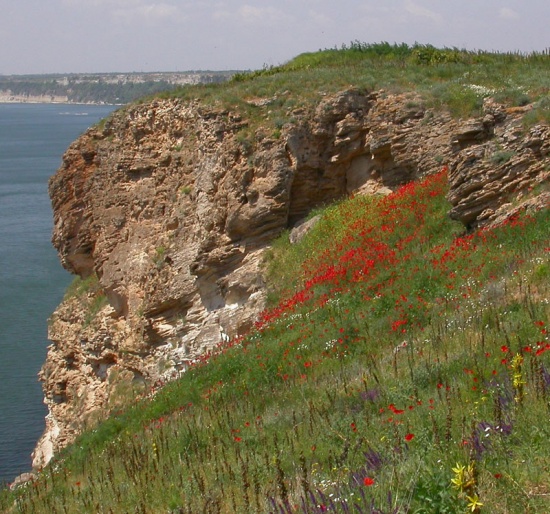| This article is incomplete. This article is missing one or more sections. You can help the BirdForum Opus by expanding it. |
Overview
A coastal headland with 60m cliffs in the north of Bulgaria, Kaliakra is a bottleneck for migrants passing down the western shore of the Black Sea and also has breeding birds of great interest.
Birds
Notable Species
It is a nature reserve in an area of limestone cliffs with the country's only breeding Mediterranean Shag, as well as Long-legged Buzzard, Eastern Black-eared Wheatear, Pied Wheatear and Isabelline Wheatear, possibly also Saker Falcon. Yelkouan Shearwater may be seen from the point and terns and Yellow-legged Gull is usually present.
On the way to the point itself are patches of stony steppe with scrub and grassland where Stone-curlew and various shrikes, larks and buntings breed as well as Spanish Sparrow. Small numbers of Great Bustard may still winter in this area and possibly also Red-breasted Goose. A wooded valley on the plateau to the north of the cape has freshwater and reedbeds with a variety of warblers, including Barred Warbler, Eurasian Golden Oriole, Common Nightingale and Hawfinch as well as breeding Eurasian Eagle Owl and Great Spotted Woodpecker and Syrian Woodpecker.
It is the migrants, however, that attract most birders. Regular during autumn passage are both storks, Great White Pelican and Pygmy Cormorant. Raptors include European Honey Buzzard, Common Buzzard and Long-legged Buzzard, Black Kite, all four harriers and Levant Sparrowhawk, Lesser Spotted Eagle, Booted Eagle and Short-toed Eagle. Red-footed Falcon and Saker Falcon also occur regularly. Passerines also occur in large numbers and include Eurasian River Warbler, Lesser Grey Shrike and Red-breasted Flycatcher. In some years flocks of Rose-coloured Starling occur at the cape.
Check-list
Birds you can see here include:
Little Grebe, Red-necked Grebe, Black-necked Grebe, Yelkouan Shearwater, Great Cormorant, Mediterranean Shag, Pygmy Cormorant, Great White Pelican, Black Stork, White Stork, Ruddy Shelduck, European Honey Buzzard, Black Kite, Short-toed Eagle, Western Marsh Harrier, Hen Harrier, Pallid Harrier, Montagu's Harrier, Eurasian Sparrowhawk, Levant Sparrowhawk, Northern Goshawk, Common Buzzard, Long-legged Buzzard, Lesser Spotted Eagle, Booted Eagle, Osprey, Lesser Kestrel, Red-footed Falcon, Merlin, Northern Hobby, Eleonora's Falcon, Saker Falcon, Great Bustard, Stone-curlew, Yellow-legged Gull, Sandwich Tern, Common Tern, Eurasian Eagle Owl, European Nightjar, Pallid Swift, Alpine Swift, European Bee-eater, European Roller, Eurasian Hoopoe, Great Spotted Woodpecker, Syrian Woodpecker, Calandra Lark, Greater Short-toed Lark, Wood Lark, Tawny Pipit, Thrush Nightingale, Common Nightingale, Isabelline Wheatear, Pied Wheatear, Eastern Black-eared Wheatear, Eurasian River Warbler, Common Reed Warbler, Great Reed Warbler, Eastern Olivaceous Warbler, Olive-tree Warbler, Barred Warbler, Lesser Whitethroat, Common Whitethroat, Collared Flycatcher, Red-breasted Flycatcher, Eurasian Golden Oriole, Red-backed Shrike, Lesser Grey Shrike, Common Jay, Rose-coloured Starling, House Sparrow, Spanish Sparrow, Eurasian Tree Sparrow, Common Rosefinch, Hawfinch, Cirl Bunting, Black-headed Bunting, Ortolan Bunting, Corn Bunting
Other Wildlife
The now extremely rare Mediterranean Monk Seal can sometimes be seen off the cape and dolphins are regular. The best time to visit is undoubtedly autumn and September in particular, although there is some spring passage and there are interesting birds in summer.
Site Information
History and Use
To do
Areas of Interest
To do
Access and Facilities
Varna, on the coast about 75km to the south of the Cape, has an international airport and plenty of accommodation and the Golden Sands resort north of Varna is a major tourist development. Leave Varna northwards on the E87 to Kavarna where there are hotels and a campsite and road and bus service to Balgarevo and on to the Cape. The Cape itself has a car park and cafe/wine bar.
Contact Details
To do
External Links
Content and images originally posted by Steve
Reviews
Steve Lister's review
Pros
- Good restaurant near the point. Easy to see Pied Whe atears several pairs between the carpark and the end. Probably the best sea-watching site in Bulgaria. Excellent for migrants and flowers . Bolata lakes are attractive to passage birds.
Cons
- Can be busy with tourists.
Roller's review
The spot is interesting for passage birds and near its vicinity it is a good place to spot Stone Curlews.
Pros
- Nice spot for reptiles
- flowers and birds




